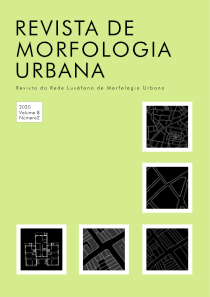Abstract
Urban mobility in cities has presented several problems. Cyclists and pedestrians face challenges to get space to move along with motor vehicles that are gaining more and more space in cities. The walkability can be an important tool for assessing how attractive the environment is for pedestrians. This article seeks to contribute to an understanding of the paths that the scientific production on walkability has been taking in the last years presenting a bibliometric analysis referring to the period of the years between 2000 and 2018. The results show the analyses of 1,112 publications according to their quantitative evolution during the time period and their contributions by country and by researcher. It can be verified that the research on walkability is on the rise and that the United States is ranked as the country with the most publications in the area.
References
Bibview. (2018). BibView – Análise Bibliométrica online. Disponivel em <https://diegocavalca.shinyapps.io/bibView/> [Acesso em: 16 maio 2018].
Brasil. (2015). Ministério das cidades., PlanMob – Caderno de referencia para elaboração de um plano de mobilidade urbana. 2015. Secretaria Nacional de Transporte e da Mobilidade Urbana – SeMob. Disponível em< http://www.cidades.gov.br/images/stories/ArquivosSE/planmob.pdf> [Acesso em: Maio 2018].
Chiu, W. T.; Ho, Y. S. (2005). Bibliometric analysis of homeopathy research during the period of 1991 to 2003. Scientometrics, 63(1), 3-23.
Coullias, A. (2013) Barriers and facilitators of walkability analysis of street network and urban design characteristics around central Florida elementary schools. Thesis (Master of Arts in Urban and Regional Planning) University of Florida.
Chung, M. K. (2011) Walkability assessment in a Transit Oriented Development Setting: A pilot study using a geographic information system. Master of Science in Communities and Regional Planning.
Daim, T. U.; Rueda, G.; Martin, H.; Gerdsri, P. (2006) Forecasting emerging technologies: Use of bibliometrics and patent analysis. Technological Forecasting & Social Change, v. 73, p. 981–1012.
Elsevier (2018). Scopus. Editora Elsevier. Disponível em: <https://www.elsevier.com/americalatina/pt-br/scopus>. [Acesso em: 23 abr 2018].
Frank, L. D.; Sallis, J. F.; Saellens, B.E.; Leary, L.; Cain, K.; Conway, T.L.; Hess, P.M. (2009) The development of a walkability index: Application to the neighborhood quality of life study. School of Community and Regional Planning, University of British Columbia.
Glazier, R. H.; Weyman, J.T.; Creatore, M.I.; Gozdyra, P.; Moineddin, R.; Matheson, F.I.; Dunn, J.R.; Booth, G.L. (2012). Development and validation of an urban walkability index for Toronto, Canada. Toronto Health Profiles.
Leslie, E.; Cofee, N.; Owen, N.; Bauman, A; Hugo, G. (2007) Walkability of local communities: using geographic information systems to objectively assess relevant environmental attributes. Health & Place, p.111-121.
Mc Kinney, O. A. (2014) An Investigation of Methodologies for Determining Walkability and its Association with Socio-Demographics: An Application to the Tampa - St. Petersburg Urbanized Area. ProQuest Dissertations and Theses, p. 299.
Nascimento, L. V. M. (2016) Análise de fatores para a caminhabilidade na cidade de Manaus. II ENSUR – Encontro de Sustentabilidade Urbana, Anais.
Nyagah, P. (2015) A Multi-Procedural Approach to Evaluating Walkability and Pedestrian Safety. Dissertation (Master Civil & Environmental Engineering) University Nevada.
Pacheco, P.; Caccia, L. (2019) Nossa cidade: Cinco exemplos de caminhabilidade. WRI Brasil. Disponível em: https://wribrasil.org.br/pt/blog/2019/10/5-exemplos-de-caminhabilidade. [Consultado em:15 de dezembro de 2019].
Siqueira, G. D. P; Lima, L. P. (2015), A contribuição das políticas públicas de mobilidade urbana para o desenvolvimento sustentável das cidades. VI Simpósio Nacional de ciência, tecnologia e sociedade, ESOCITE/TECSOC. Rio de Janeiro.
Southworth, M. (2005) Designing the Walkable City. Journal of Urban Planning and Development, v. 131, n. 4, p. 246–257.
Soares, P. B.; Carneiro, T.C.J.; Calmon, J.L.; Castro, L.O.C.O. (2016) Análise bibliométrica da produção científica brasileira sobre tecnologia de construção e edificação na base de dados Web os Science. Ambiente Construído. Vol.16, N.1, Jan/maç.
Thayer, T.C. (2016) Urban Walkability measures: Data quality, cautions, and associations with active and public transportation across Canada. Electronic Thesis and Dissertations Repository, paper 4114.
Vosviewer. (2018) Welcome to VOSviewer. Center for Science and Technology Studies. Disponível em: <http://www.vosviewer.com>. [Acesso em: 24 abr. 2018].
Wang, Q.; Yang, Z.; YAng, Y.; Long, C.; Li, H. (2014). A bibliometric analysis of research on the risk of engineering nanomaterials during 1999–2012. Science of the Total Environment, 473, 483-489.
Zupic, I.; Cater, T. (2015) Bibliometric Methods in Management and Organization. Organizational Research Methods. Vol. 18(3) 429-472.

This work is licensed under a Creative Commons Attribution 4.0 International License.
Copyright (c) 2020 Taiany Richard Pitilin, Suely da Penha Sanches


